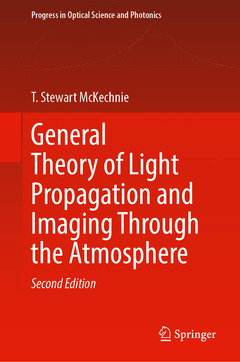General Theory of Light Propagation and Imaging Through the Atmosphere (2nd Ed., 2nd ed. 2022) Progress in Optical Science and Photonics Series, Vol. 20
Auteur : McKechnie T. Stewart

This 2nd edition lays out an updated version of the general theory of light propagation and imaging through Earth?s turbulent atmosphere initially developed in the late ?70s and ?80s, with additional applications in the areas of laser communications and high-energy laser beam propagation. New material includes a chapter providing a comprehensive mathematical tool set for precisely characterizing image formation with the anticipated Extremely Large Telescopes (ELTS), enabling a staggering range of star image shapes and sizes; existing chapters rewritten or modified so as to supplement the mathematics with clearer physical insight through written and graphical means; a history of the development of present-day understanding of light propagation and imaging through the atmosphere as represented by the general theory described. Beginning with the rudimentary, geometrical-optics based understanding of a century ago, it describes advances made in the 1960s, including the development of the ?Kolmogorov theory,? the deficiencies of which undermined its credibility, but not before it had done enormous damage, such as construction of a generation of underperforming ?light bucket? telescopes. The general theory requires no a priori turbulence assumptions. Instead, it provides means for calculating the turbulence properties directly from readily-measurable properties of star images.
Features many updates and a new chapter providing a comprehensive mathematical tool set
Enhances understanding through tables with mathematical notations at the end of each chapter
Offers methods for rapid identification of ‘sweet spot’ wavelength regions
Date de parution : 10-2023
Ouvrage de 678 p.
15.5x23.5 cm
Date de parution : 10-2022
Ouvrage de 678 p.
15.5x23.5 cm



